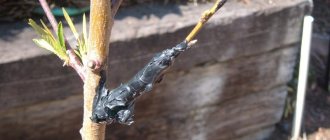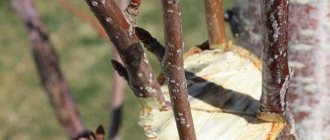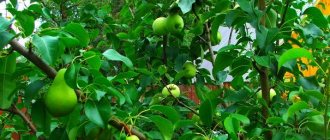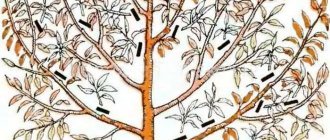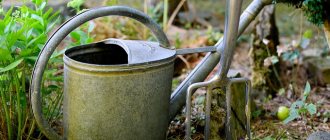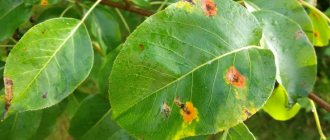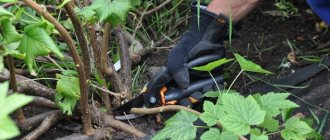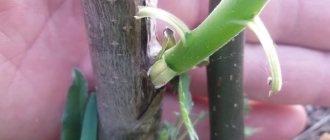Thanks to a successfully completed grafting procedure, you will be able to grow a heat-loving apricot on a zoned frost-resistant rootstock even in Siberia (what can we say about the Middle Zone). But vaccination may have other purposes.
The features and methods of apricot grafting in spring and summer will be discussed in detail later in this article.
Why is vaccination necessary?
Proper vaccination allows you to:
- increase the endurance of the crop, resistance to frost, cold winds, diseases, incl. acclimatize to cultivation in a specific region;
- get a larger yield of self-fertile varieties due to cross-pollination;
- grow several varieties of crops (differing in fruiting time and fruit characteristics) on one tree;
- speed up the onset of fruiting.
Failed Attempts
Surely they are familiar to you too. When buying rosy apricots, you can’t help but think that it would be a good idea to plant a seed. What if it sprouts... Some time passes and a tiny sprout appears on the surface of the earth. This is the first victory, but it’s too early to rejoice, because it won’t survive on your site on its own roots. It must be said that it is also not suitable for growing as a houseplant. For this purpose, special varieties are bred separately. However, while the seedling is gaining strength, there is time to think about what the apricot can be grafted onto.
What is apricot grafted on?
An important task when preparing for apricot grafting is the choice of rootstock crop. It is the rootstock that will ensure improved quality characteristics of the crop.
Apricot
The best option is considered to be closely related grafting, when an apricot cutting is grafted either onto an existing cultivated apricot on the site or onto a wild one. It is easiest to graft an apricot onto an apricot - their compatibility is very high.
Dichok provides endurance, frost resistance, and disease resistance. It does not form root growth throughout the entire area. The only disadvantage of such a rootstock is the pre-heating of the trunk.
Plum
The high compatibility of crops, as well as the prevalence of plums even in northern regions, make it a promising candidate for grafting.
Plum rootstock increases the resistance of apricot to temperature fluctuations and allows you to grow the southern crop on acidified soil that it does not like. Grafting apricot onto plum has proven itself in the regions of Central Russia.
Cherry plum
Grafting apricot onto cherry plum is justified not only by increasing its resistance and endurance, but also by increasing the sweetness of the fruit and giving a pleasant taste.
One of the disadvantages of the rootstock is the formation of numerous root shoots.
Damsons
Grafting apricot onto sloe provides it with high tolerance to cold and unfavorable conditions. However, numerous shoots may appear, annoying the gardener. A more acceptable option would be damson grafting: it ideally combines the sustainability of a wild crop and “domestication.”
Cherry
The cherry rootstock gives good endurance and compactness of the crown. However, the fragility of cherry wood does not allow it to withstand the loads of large harvests: at the peak of fruiting, the branches cannot withstand and break.
You can sequentially graft cherry plums or plums onto cherries, and apricots onto them. However, the procedure is too labor-intensive and lengthy, so it is not popular.
Peach
Peach rootstock is the rarest option used for apricot grafting, since it grows only in the southern regions. The cultures combine well with each other, but at the slightest frost the peach rootstock will freeze.
Comparative table for choosing apricot rootstock depending on the region
| Growing region | Recommended rootstock |
| Siberia and the Urals | Manchurian apricot |
| Central Russia (including the Moscow region) | Manchurian and common apricot (seedlings) Plum Ternoplume Cherry plum |
| Southern regions | Semi-cultivated apricot (perch) Peach |
The choice of zoned crops for the rootstock will improve the characteristics of the apricot scion.
When, how and how much: basic rules
All experts and amateur gardeners agree that the best time for grafting is spring, since in the fall the cuttings may not have time to take root before frost. True, there is also a winter grafting, but it is used for pear, apple and plum trees. In our case, the apricot cuttings should be grafted strictly in the spring and nothing else, when active sap flow in the tissues begins. Since there are still frosts at night at this time, you need to wait until it gets warmer (usually from late April to early May). In summer, apricots can be grafted only in those regions where the warm season is long so that the cuttings have time to take root. Success is possible only if there is a warm, long season and there is confidence in the weather forecast.
It is better to graft apricots in the spring so that the cuttings have more time to take root in warm temperatures.
In order for the grafting to be successful, it is necessary to strictly follow a whole set of rules to ensure the safety of the plant during the period of its establishment.
Cuttings are prepared in advance and stored in proper conditions. Harvesting takes place in late autumn - the upper shoots are cut off and wrapped in film, after which they are stored directly in the snow. After it has disappeared, the cuttings are moved to the refrigerator, rewound with a damp cloth. Before the start of the event, they are soaked in water and the necessary instruments are prepared, which must be absolutely sterile and in full working order.
The grafting instrument must be sterile and sharply sharpened.
Another thing follows from this rule - all cuts must be made with a sharp and clean knife - after all, we are working with the internal tissues of the tree and performing an operation that in some ways can be compared with those performed on humans. The cut must also be clean.
The grafting site should be tightly tied to ensure maximum fixation of the scion. Only with close contact does the engraftment of its tissues with the tissues of the rootstock occur.
The best result is achieved when grafting the same varieties - in this case the plant will grow resistant to drought and frost and without shoots, and the fruits will be large and juicy. Therefore, grafting apricot onto apricot is the best of all options.
The grafting procedure itself takes a few minutes, but the grafting time of the scion may vary, but the result of your work will be obvious when the first leaves appear on the cutting. Apricot grafting allows you to get a harvest earlier than with conventional seedling cultivation. For example, if a new seedling bears its first fruits in 3-4 years, then a grafted cutting will be able to please you with a harvest in 2-3 years. It happens that after a year the first ovaries appear on the apricot, but it is better to remove them to stimulate active growth of the branch.
You can judge the success of the grafting by the first leaves that appear on the scion.
Which trees are not suitable for apricot grafting?
Not all fruit trees living in the garden are suitable for apricot grafting. Vaccination is hopeless:
- on rowan;
- on irgu;
- for cherries;
- to the apple tree;
- on the pear.
The graft survival rate for these crops is extremely low. Even if successful, the apricot tree may die over time or may never bear fruit.
This is due to the fact that grafting of stone fruit crops should be carried out only on stone fruits, and grafting of pome crops – on pome fruits.
Spring or summer - when is it better to vaccinate?
Vaccination is allowed during the following periods:
- In spring - carried out after the establishment of positive daily temperatures during the swelling of the buds, i.e. at the very beginning of sap flow. For different regions, these dates are different - from the end of March to the end of April. When there is a threat of frost, the scion and rootstock are insulated with any light covering material.
- In summer - produced during the second sap flow in late July - early August. Green apricot cuttings (this year) are used as a scion. Readiness for grafting is determined in practice: if the bark of the rootstock easily comes away from the wood, the activity can be carried out.
- In the southern regions, apricot grafting is allowed in early autumn. If the warm autumn period drags on, the scion will have time to grow. It is recommended to insulate the grafting site with sphagnum moss or sawdust.
Selection and preparation of apricot scion
To carry out grafting, apricot cuttings should be properly prepared.
In autumn
For spring grafting, cuttings should be prepared in the fall. They are cut with a sharp knife or pruning shears at the end of autumn, when mild subzero temperatures set in, then tied into bunches and put away for storage. How this is done - watch the video:
There are several ways to save cuttings until spring:
- in a snowdrift (at a depth of at least 50 cm) in a plastic bag with an open end so that the cuttings can breathe;
- in the refrigerator, first wrapping them in a slightly damp cloth or newspaper, then in polyethylene;
- in the cellar, placing it in a box with wet sawdust or sand.
Expert commentary. Throughout the winter, it is necessary to maintain the ambient temperature as close to zero as possible, so as not to provoke the awakening of the cuttings and begin the growing season.
Immediately before starting work, the cuttings are soaked for 8-10 hours in water. You can prepare cuttings in the spring immediately before grafting, but there is a possibility of choosing a frozen, damaged or weakened shoot.
Green cuttings in summer
In summer, freshly cut green cuttings are used for grafting, harvesting them early in the morning in dry weather. If it is necessary to transport or store the scion, it should be placed in a damp cloth and in a plastic bag.
Store in a cool place for up to two weeks. The longer the scion is stored, the weaker it becomes. Some of the leaves are first removed from the cuttings to reduce moisture loss.
Reviews
About the results of last year's grafting of apricot cuttings into plums. The growth rate is from 50 to 70 cm (flower buds are laid on the grafts). I grafted an apricot for the first time. The vaccination sites are marked with a bandage. Grafted into the crown or onto a trunk above 50 cm from the soil (lots of snow in winter).
Apricot cuttings grafted onto plum trees grew 50–70 cm
https://forum.prihoz.ru/viewtopic.php?p=634457#p634457
It is better to graft apricot onto the so-called damson. But in this case, the probability of growth is very high. To reduce its formation, you need to graft as low as possible, next to the root collar of the rootstock.
Olya
https://greenforum.com.ua/archive/index.php/t-61.html
Not everything is simple with plum rootstocks for apricots. In January I received two winter vaccinations each of Northern Triumph and Kompotny. All grew equally, but both compotes suddenly dried out when the shoots were 10–12 cm long. And ST is still alive today. I asked R.G. Nozdracheva. The answer was "INCOMPATIBLE WITH ROOTSTOCK."
PS. I will beg for apricot-shaped seeds (I forgot the name) for growing rootstocks.
Zener
https://forum.prihoz.ru/viewtopic.php?p=587776#p587776
I grafted an apricot onto a plum 2 years ago. I took cuttings from my old apricot tree (my father planted it). I don’t know the variety, but the whole family likes apricots. Large, sweet, hang well on the tree while they ripen. We decided not to tempt fate, but to grow what we like.
I grafted it into a split on a plum shoot about a centimeter in diameter. I grafted it in the spring, after a couple of months I unwound the tape and it took root well. This year the first berries have grown - you can’t tell them apart from their parents. The family is happy!
Sergey999
I want to share my first experience with vaccinations. Last spring I grafted 10 apricot cuttings from Nikitsky red-cheeked. Cuttings were cut in advance in the fall. Grafted by copulation onto plum shoots. A year has passed - ten out of ten have taken root! In the fall I will distribute to friends and neighbors)) I will plant two at home.
Nikitos
Grafting apricots onto plum rootstock in the spring gives positive results and high survival rates. The seedlings are of excellent quality, winter-hardy and healthy. The grafting process using the described methods is simple and can be performed by novice gardeners.
Where to plant an apricot
The choice of place for grafting on the rootstock is determined by its purpose:
- to cultivate shoots or wildflowers, they are attached to the root collar;
- if there is a ready-made three-year standard, grafting is carried out at a height of 60 cm from the ground;
- on a young tree, grafting is done on a skeletal branch (5-10 cm away from the connection with the trunk);
- mature trees are grafted in several places on second-order branches.
The figure shows the names of the various parts and the order of the branches of the tree.
Why is the rootstock of an apricot tree important?
Modern large-fruited apricot varieties are propagated by grafting. The correct type of rootstock is very important; with its help you can:
- reduce the height of apricot trees;
- increase their frost resistance;
- reduce the risk of winter heating of the bark at the root collar - this is one of the main reasons for the death of apricot trees in the middle zone and other regions with deep snow and frequent winter thaws.
Grafted apricot trees begin to bear fruit 3–5 years after planting in the garden.
Choosing the right rootstock is the key to a bountiful apricot harvest
Tools and methods of grafting
To work you will need:
- pruning shears, knife, hatchet, saw - for preparing the rootstock and scion;
- electrical tape, rope, film for fixing the vaccination site;
- garden pitch, putty, healing paste;
- if there are several vaccinations, after each one you need to disinfect the instrument with alcohol.
Depending on the timing, goals and material used, the method by which the apricot will be grafted is selected.
Copulation
Can be used at any time. A method that involves connecting a rootstock and scion of equal diameter:
- The cuttings and rootstock are cut at an acute angle (cut length - 2-3 cm).
- The cut parts are connected to match the cambium as much as possible.
- The joint is coated with garden varnish and tightly wrapped with film or tape.
The video shows a method of improved copulation, which allows you to make a better articulation of the rootstock and scion.
Into the cleft
The method is used to graft one or more cuttings onto a large radius rootstock. Apply in spring.
- The prepared cuttings are cut on both sides, forming a double wedge.
- The sawn and trimmed rootstock (trunk) is split with a hatchet or knife to a depth slightly greater than the length of the cut on the handle.
- The cutting is fixed at the splitting site so that the cambium and bark of the grafted parts coincide.
- The junction is coated with garden varnish and wrapped with tape.
Budding
For grafting using this method, only the scion bud is used. Apply in spring.
- Cut off the bud “with a heel” (with a piece of bark and wood).
- A T-shaped cut is made on the bark of the rootstock.
- They place the bud under the bark.
- Cover the cut with garden varnish and securely fix it.
Another variation on the theme of apricot budding is shown in the following video:
For the bark
The method is suitable for early spring grafting of cuttings onto an adult rootstock.
- The cuttings are cut wedge-shaped.
- The rootstock (trunk or branch) is cut down and cleaned.
- At the place of cutting, make an incision of 5 cm and bend the bark, insert cuttings into the crevice at a short distance from each other.
- The connection is covered with varnish and firmly fixed with tape.
Into the side cut
A method of spring cultivation of wild rootstocks, as well as increasing the yield of mature trees.
- Make a double wedge on the handle.
- On the rootstock, make a side cut down to the wood for the length of the cutting wedge.
- Fix the scion in the rootstock, cover it with garden varnish and secure it with tape.
How to properly graft trees: step-by-step instructions
To learn how to graft a tree correctly and reliably, it is useful to watch a master class by experienced gardeners recorded on video.
Here is how the process of correct grafting on an adult plum proceeds using the improved copulation method:
- In the spring, before the buds open on the plum tree, all unnecessary branches growing towards the trunk, rubbing against the trunk and other unnecessary branches that will prevent light from reaching future grafts are cut off.
- After pruning, vertically growing branches are selected from the donor tree, whose diameter coincides with the thickness of the previously prepared cuttings of the grafted varieties.
- On each pair, oblique cuts are made with a special knife, which must coincide in length with each other.
- On each of the sections, tongues are made, which are longitudinal cuts 15–20 mm long, starting from the middle of the sections.
- Then the rootstock and scion are tightly connected to each other. In this case, the tongues overlap each other, which makes the contact of the grafted objects more reliable.
- The grafting sites are tightly wrapped with electrical tape or grafting tape.
Video: how to properly graft trees
Common mistakes
Errors during vaccination nullify all the results of the work. The most common ones include:
- leaving the growth below the grafting site - as a result, the scion is deprived of nutrition and the cutting dries out;
- the scion and rootstock must be healthy, without signs of disease, pests, or wilting;
- grafting in wet weather increases the risk of scion dying;
- insufficient watering reduces the supply of moisture and nutrients to the grafting site and leads to its death;
- If the first flowering occurs the following year, be sure to remove the flowers so as not to weaken the graft.
Grafting an apricot, carried out according to all the rules, will allow you to avoid mistakes and get a healthy apricot tree, which will bear fruit in 3-4 years.
What is tree grafting
Since when growing fruit trees from their seeds or seeds, the resulting plants, with rare exceptions, do not retain the positive qualities of their parents, one has to resort to vegetative propagation. This is the name of the method in which part of a tree with the necessary qualities, in the form of a cutting, called a scion, is grafted onto a donor tree, called a rootstock.
The rootstock supplies the scion with nutrition and provides it with frost resistance. The scion , exploiting the nutritional forces of the donor tree, produces fruits with previously known desired properties. As a result, from one fruit tree you can collect fruits of various varieties of the same species and even other fruit species that are compatible with it during the grafting process.
